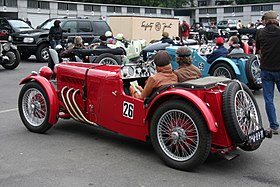| MG F-Type "Magna" | |
|---|---|
| Overview | |
| Manufacturer | MG |
| Production | 1931-1932 1250 built[1] |
| Body and chassis | |
| Class | sports car |
| Chronology | |
| Predecessor | none |
| Successor | MG L-type Magna |
| MG F1 | |
|---|---|
| Overview | |
| Production | 1931-1932 |
| Body and chassis | |
| Body style | 4-seat open tourer Foursome Coupé |
| Powertrain | |
| Engine | 1271 cc In-line 6 |
| MG F2 | |
|---|---|
 | |
| Overview | |
| Production | 1932 |
| Body and chassis | |
| Body style | 2-seat open tourer |
| Powertrain | |
| Engine | 1271 cc In-line 6 |
| MG F3 | |
|---|---|
| Overview | |
| Production | 1932 |
| Body and chassis | |
| Body style | 4-seat open tourer Foursome Coupé |
| Powertrain | |
| Engine | 1271 cc In-line 6 |
The MG F-type Magna is a six-cylinder-engined car that was produced by MG from October 1931 to 1932. It was also known as the 12/70.
Looking for a car to fill the gap between the M-Type Midget and the 18/80, MG turned to another of the engines that had become available from William Morris's acquisition of Wolseley. This was the 1271 cc 6-cylinder version of the overhead camshaft engine used in the 1929 MG M type Midget and previously seen in the 1930 Wolseley Hornet and had dummy side covers to disguise its origins. Fitted with 1 in (25 mm) twin SU carburettors it produced 37.2 bhp (27.7 kW) at 4100 rpm at first, later increased to 47 bhp (35 kW) by revising the valve timing. Drive was to the rear wheels through a four-speed non-synchromesh gearbox of ENV manufacture. The chassis was a 10-inch (250 mm) longer version of the one from the MG D-type with suspension by half-elliptic springs and Hartford friction shock absorbers all round with rigid front and rear axles. Wire wheels with 4.00 x 19 tyres and centre lock fixing were used. The car had a wheelbase of 94 in (2,388 mm) and a track of 42 in (1,067 mm).[2]
With its sloping radiator and long bonnet the F-Type is an attractive car capable of reaching 70 mph (110 km/h). 188 of the cars were supplied in chassis form to outside coachbuilders such as Abbey, Jarvis, Stiles and Windover.[2]